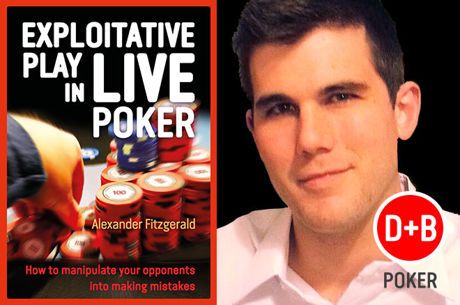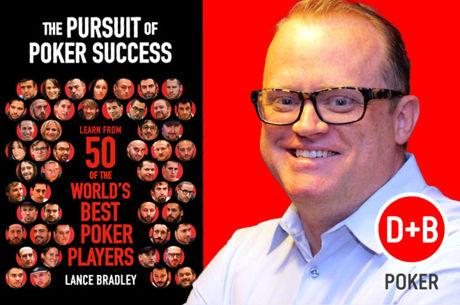Book Excerpt: 'FossilMan's Winning Tournament Strategies' by Greg Raymer

FossilMan's Winning Tournament Strategies is the ultimate guide to practical tournament play. Greg "FossilMan" Raymer, winner of the WSOP Main Event in 2004, explains everything you need to know to become a successful tournament player. Raymer is not only a big winner at the tables, he also has a unique ability to explain difficult concepts in clear and simple language.
Raymer simplifies the learning process by breaking down the complex subject of tournament strategy into the key areas. Chapters on strategy include: the Independent Chip Model (ICM), game theory, poker maths and pot odds, correct bet-sizing, playing the big stack, and playing the short stack.
However, Raymer does not focus merely on the correct technical aspects of standard No-Limit tournament play. He also discusses many other important tournament formats that often confuse players. These include:
- how strategy changes in satellite and rebuy tournaments-
- how to play heads-up events and other uncommon formats
- how to play the Main Event
The 248-page book comes out in June. Read an excluvive book excerpt, right here on PokerNews:
| Title: | FOSSILMAN'S WINNING TOURNAMENT STRATEGIES |
| Author: | Greg Raymer |
| Publisher: | D&B Poker |
| Price: | $29.95 (paperback), $19.95 (eBook) |
| Pages: | 248 |
| Publication Date: | June 2019 (one month earlier than advertised) |
You can pre-order a copy of the ebook or physical book from D&B’s website.
Board Texture
One of the most important factors to take into account when making your de¬cision whether to check, bet, raise, or fold, as well as how much, is the texture of the board. When we refer to the texture of the board, we are only talking about the cards on the board, and not the cards you are holding. Board texture is often referred to as coordinated or uncoordinated (the terms wet and dry are also often used). A coordinated (wet) board is one that has more than average potential for straights, flushes, and draws to the same. An uncoordinated (dry) board has below average potential for straights, flushes, and draws.
Sometimes the rank of the cards is also taken into account, as a board that has mostly higher ranking cards is more likely to have hit a typical starting hand than a board that has mostly lower ranking cards. For example, if the players were holding random cards, then a flop of J♠10♠9♦ and a flop of 6♣5♣4♥ should both be equally likely to have connected with their cards. But in the real world, people are more likely to play starting hands that connect with the J♠10♠9♦ flop, and are more likely to fold starting hands that connect with the 6♣5♣4♥ flop.
By considering board texture, you can do a much better job of determining if you should check, bet, call, or raise. The more coordinated the board, the more dangerous it might be to give the opponent a free card. And if you’re thinking of slow-playing, board texture is one of the most important factors to consider (see Chapter 16).
Overall, the most important thing about board texture, is that the more coordinated the board, the more likely it is to have connected strongly with the opponent’s starting hand. The ultimate wet board would be a flop like J♥10♥9♥. On this flop, anybody with two hearts already has a flush, and anybody with one heart has a flush draw. There are already three starting hands that have made a straight (KxQx, Qx8x, and 8x7x), and every hand that includes a king, queen, 8 or 7 has a straight draw. Additionally, since players are more likely to play coordinated starting hands (hands where the two cards are the same suit and/or close to each other in rank), a player is more likely to have flopped two-pair on a coordinated flop than a dry flop. Compare this flop of J♥10♥9♥ to a completely dry flop like K♦8♥4♣; most players are much more likely to play Jx10x, Jx9x, or 10x9x as compared to Kx8x, Kx4x, or 8x4x.
Therefore, whether you are playing a pot that is already heads-up, or still multiway, the more coordinated the board, the more likely it is that one or more of you have connected with the flop. And of course we’re not just talking about the flop either. You will want to pay attention to how coordinated the board is on the flop, turn, and river. Even a very dry flop like Q♠8♥5♦ can quickly become rather wet when the 9♠ is dealt on the turn. All of a sudden two different made straights are possible, a flush draw has just materialized, and numerous straight draws are now possible as well.
In addition to considering board texture, you should also consider how like¬ly it is that this board has connected with your opponent’s range of hands. If your opponent was the last aggressor, they are probably more likely to have higher cards, so the higher the cards on the board, the more likely this board has connected with their hand. It will of course be obvious to you whether or not your hand has connected with the board, but you also need to keep in mind the concept of whether or not the board is likely to appear to your opponents to be a board that has connected with your hand. If they are likely to perceive the board as one that hit you, you probably have more room to bluff, but less room to extract value (when it actually has hit you). No matter which person you are at the moment, some boards look like they are more likely to have connected with the aggressor, and some boards look better for the caller(s).
And when the turn and/or river cards are dealt, you should be considering whether those are cards that appear to be good bluffing cards, for you and for your opponent(s). If one player has been calling on a wet board, and the next card might have complet¬ed their flush and/or straight draw, any good player will realize that the caller might now easily have the best hand. As such, you should expect that player’s perception of the relative strength of their hand to change significantly.
Just remember to always be aware of the board texture, as in many cases it will be more important than even the two cards you are holding in determining your best decision.
Sponsored content provided by D&B Publishing.








